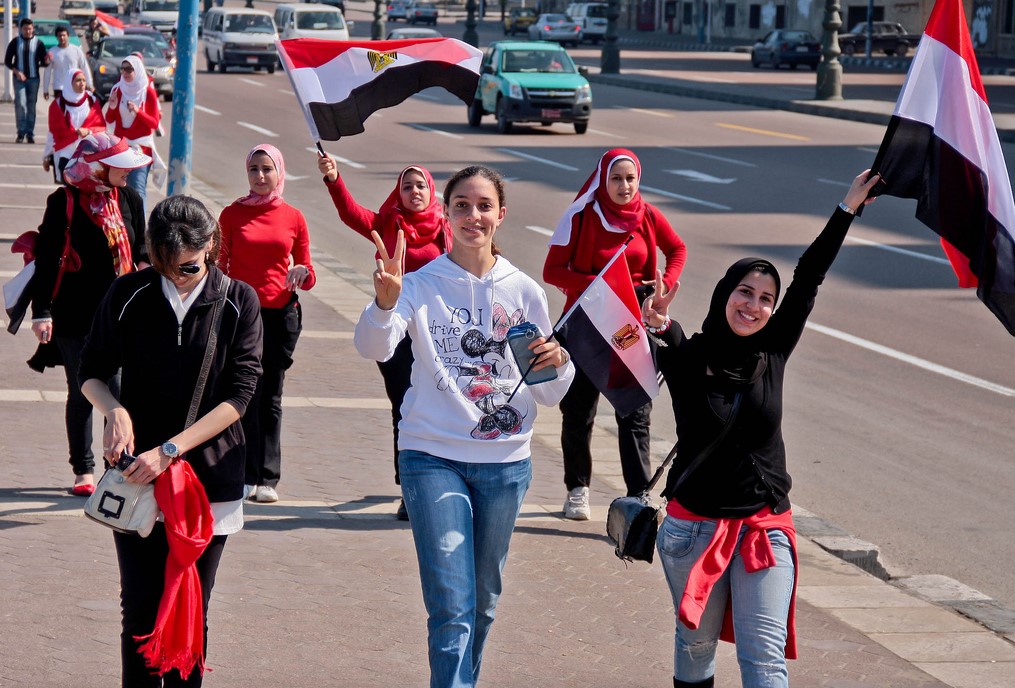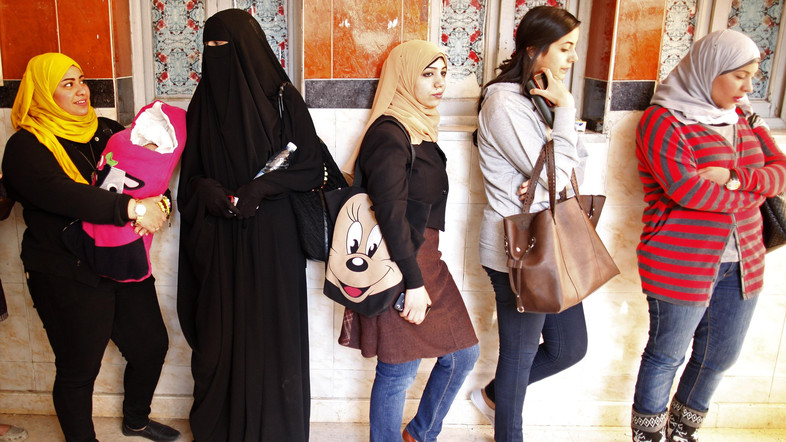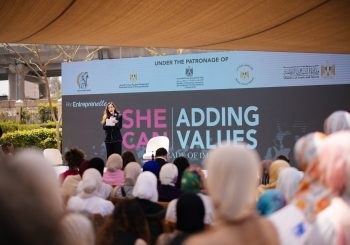Several decades ago, it was rather uncommon for a young woman in Egypt to take up the highly observant lifestyle of wearing a hijab. Even in the countryside, where covering one’s hair was common among Muslim and Christian women alike – and even among men – it was seen as more of a custom than a religious act. But with the arrival of the 1970s, the Islamic veil became more and more commonplace; a sign of religiosity at times, and a social dress code for Muslim women at others.
Nowadays, however, in an Egypt where wearing the hijab has become the default for a significant number of women, the choice to remove it has in many circles become the more controversial one. Although there is no statistical evidence to confirm it, there has been an identifiable wave of women taking off the hijab over the past few years that is unprecedented since its gradual surge over the decades.
Egyptian Streets had the opportunity of speaking with three young women, Yasmine*, Maya*, and Lina, who removed their hijab, to learn about their unique journey on either side of this topic. The following is an account of their stories as they told them.
Lina comes from a family she describes as conservative. After going to ‘Umra (a secondary Islmaic pilgrimage to Mekka) at age 10, her mother and a Sheikh convinced her that it would be the right decision to wear the hijab. She complied.
Maya’s parents met in the middle. Her father was the most liberal in a rather conservative family, and her mother the most conservative in a rather liberal family. Maya decided to wear the hijab at the age of 16 after going to ‘Umra. Her mother’s positive response was the most emphatic. Though the decision was her own, Maya notes with the benefit of hindsight that there may have been pressure she only took notice of after a process of reflection and introspection: She was the youngest of her siblings, and because they were more rebellious, she felt a responsibility to be the model child. She wanted to do well in school and be religiously observant. She felt like she owed it to her parents.
Yasmine made the decision to wear the hijab completely on her own at age 12, but she does acknowledge that the social dress code may have played a role where she grew up in town on the Nile Delta. However, her family did not pressure her to make this decision at all; in fact her father and brother encouraged her not to rush into this decision at a young age. But Yasmine insisted, because her older sister – whose observant yet accepting and knowledgeable way of religiosity she looked up to – wore the hijab.
After wearing the hijab, Lina’s relationship with her attire in general became a fraught one. For years, she and her mother were at odds over what she should wear. The argument of trousers versus skirts was one that marked the memories of her hijab-wearing years. In her final years as a school-age student, Lina went to an international school and that is where this seemingly small discussion had its most lasting effect. At her mother’s insistence, she was the only one in her surroundings that wore a maxi skirt. Stuck in this arrangement, Lina grew to harbour negative feelings towards her own body. She called it “hate”.
At Maya’s school – supposedly a progressive and diverse one – wearing the hijab immediately made her feel as though she had been placed in a different box. People who wore the hijab were either mothers, or people from a different social background. Not ones that went to this school. Her friendships changed and White Western teachers gave themselves the right to comment on her decision.
Similar to hoping to be the model child, her experience at school made her feel like she wanted to be a model hijabi. In the American University in Cairo, she finally found herself in a context where she was no longer stigmatised for wearing the veil, but rather accepted. She put thought, energy, and effort into becoming part of the hijabi community in college. She felt like she was a representation of this choice and she wanted to be a good one. Her outfits were chosen carefully and lovingly while still focusing on long and loose-fitting garments. She bought designer scarves, but always wore them as a traditional hijab, never as trendy turbans or what many call ‘Spanish’ hijabs.
As Yasmine grew older, she began to learn about gender dynamics and social disparities in Egypt. Through delving into these topics, she began to see how women’s bodies were turned into battlegrounds for political discussion by the powerful – mostly men – and how unfounded shame was governing the decisions many women were making. These thoughts awakened in her a desire to rebel against the idea that she needed to live her life in a certain way to be accepted by the community.
Lina’s step to remove the hijab in her 20s had been a long time coming. She had not been happy with the decision, which had never really been her own, and the toll it was taking on her mental health was only increasing in weight. In spite of changes in her life, her communication with her mother did not change. Her struggles with body image led her to a change in diet and lifestyle, which in turn led to a weightloss she had been hoping for. When she hit her target weight, she wanted to celebrate with a navel piercing. Her mother, in Lina’s words, lashed out.
Maya was already beginning to consider life without hijab when she saw a photograph of her aunt’s wedding. Her grandfather, the father of the bride in the photograph, was a highly influential religious authority in Egypt at the time. So influential, in fact, that the guest that featured in the photograph was the late Egyptian President Gamal Abdel Nasser. In the photo neither bride nor mother of the bride – the daughter and wife of this highly influential religious authority – wore the veil, and this in the presence of Abdel Nasser, a man who was not part of the family. This gave Maya pause.
It was Yasmine’s final year in university when she began to consider removing her hijab. She admits that the change in social surroundings may again have played a role. But in spite of reevaluating her values and beliefs, she was not quite ready to bring her family into her thought process. She already knew then that while some of her relatives would accept her decision and support it, others were likely not to.
As soon as Lina stopped living with her mother, becoming more independent, she removed her hijab. It no longer made sense for her to continue wearing it for someone else’s sake. When Lina did this, her parents cut all contact with her, and according to Lina, in their words, “disowned” her.
Maya’s journey of removing the hijab was far less abrupt. Though she had certainly begun to feel that wearing the hijab wasn’t the form of practicing her faith that was her highest priority, she was struggling to tell why she had not yet removed it: was it because part of her still believed that this was the right choice for her, or was it concern over how others may respond to the change. And so, she put it to the test. She was about to travel abroad to visit her siblings, and decided that while she is away from home, she would remove hijab to see whether, in the absence of everyone who knew her, she would feel comfortable not wearing it. And, indeed, she did feel comfortable.

Nevertheless, she was not yet ready to confront her mother or remove her hijab in Egypt. Though she identified that the only thing holding her back from the decision was the response of others to her choice, she continued to wear her hijab while thinking about all the potential repercussions of the decision. She felt the weight of potentially disappointing her mother and the weight of letting down the community she spent so much energy on becoming a part of. She felt like removing her hijab was, in her words, letting them down.
When Yasmine told her family that she planned to remove the hijab, she was met with shock. Her mother and sisters were extremely concerned, fearing that she had strayed from God. But Yasmine insisted that her relationship with God was her own. Her brother said that the choice was hers, but he frowned upon it. When Yasmine did finally remove her veil, she did not immediately inform her brother, and she says that this created a rift between them for a while. In spite of this rocky response, Yasmine was grateful that her family’s concern was a purely religious one, rather than a social one. They did not fear how society would react to her decision at all.
Before another trip abroad, this time with a group of friends, where she intended to test herself once again, Maya decided she had to confront her mother. She was met with shock and, significantly, fear. She explained that her mother, like Yasmine’s mother and sisters, feared a slippery slope into rebellion and distance from religion. But when Maya finally committed to the decision to remove her hijab after her trip abroad, her family saw how she was still the same person and that this decision has not changed her or weakened her relationship with God.
Though Yasmine did not care about the reaction of the vast majority of people around her – only her family and close friends mattered to her – she took note of how others behaved. Though most of her friends supported her, others gave themselves the right to reprimand her or tell her she needed to get closer to God. But to Yasmine the truth was clear: she needed only to listen to her own heart and the advice of the people she trusted, because as a woman, she knew she would be judged either way.

The uniqueness and individuality Lina, Maya, and Yasmine’s stories – and undoubtedly every other story of such a choice – along with the factors of family, experience, personality, and social surroundings, show the crucial role context plays in understanding such a decision.
One example of how the observation of such choices and trends out of context bears little significance is the opinion of the late progressive author, social commentator, and economics professor Galal Amin, who, in fact, argues that the hijab has been a critical tool for the emancipation of Egyptian women.
When households could no longer rely on a sole breadwinner, he argued, wearing the hijab allowed women whose families’ conservative lifestyles prevented them from exiting confined spaces, to gain employment, and thus become financially more independent peers of men.
Breaking the unbalanced dynamic of women’s financial reliance on their husbands by working for their own income strengthened women’s positions in their households, as it removed the perceived debt of dependence on a provider that had once plagued women’s family lives.
And while society may increasingly learn to accept women’s decisions to wear the hijab, remove it, or not to wear it to begin with, it is not likely that their position as essential members of the workforce and indispensable income earners at home will be reversible.
Judgement of women’s personal choices ubiquitously abounds: while many attribute the hijab to regressive conservatism, many others attribute it to piety and dedication. And while many attribute its removal to liberation and reclaiming of agency, many others attribute its removal to a decline in morals and a straying from God. Stories like those of Lina, Maya, and Yasmine show that these attributions practically never apply, and therefore any judgement is unjust, potentially extremely harmful, and, in truth, devoid of sense or meaning.
*The interviewees’ real names have been concealed at their request.
Any views expressed by the writer are their own and do not reflect the views of any institution with which they are affiliated.







Comments (2)
[…] dynamics within the Egyptian family structure shifted, so too, did the role of the woman within the […]
[…] Family, Judgement, and Choice: 3 Stories of Egyptian Ex-Hijabis […]